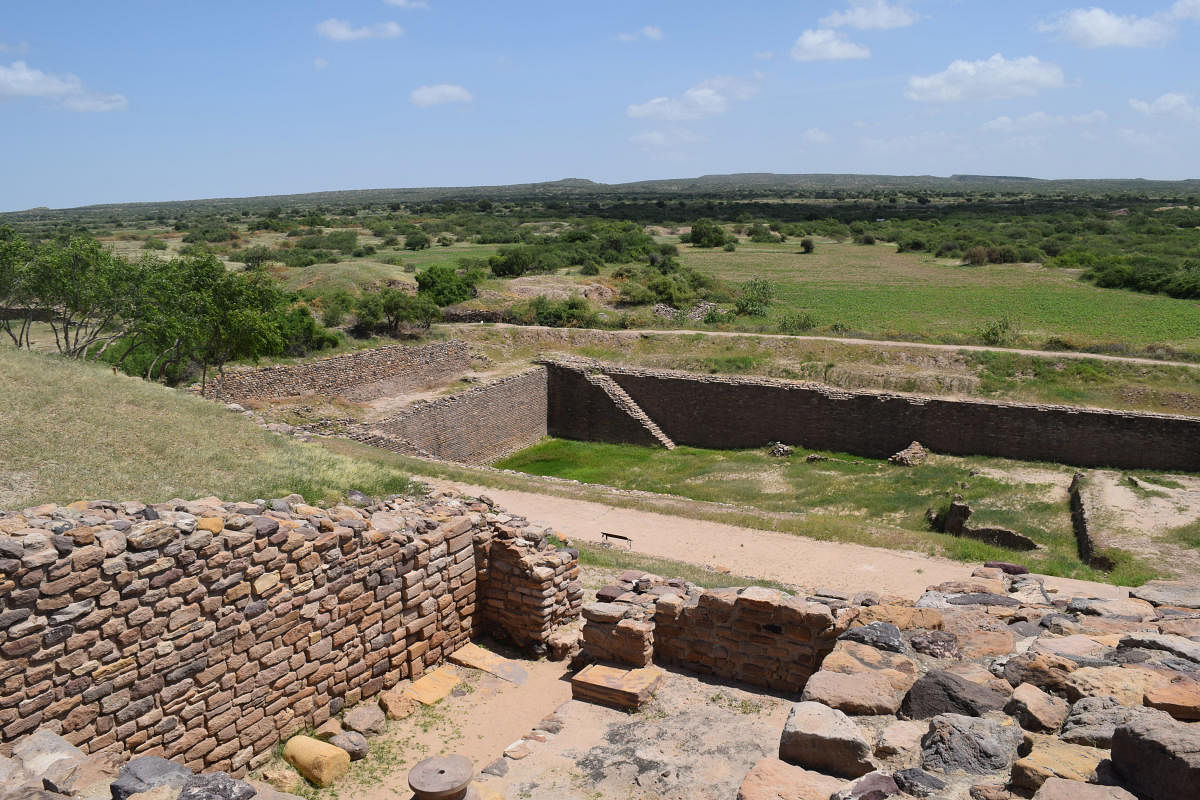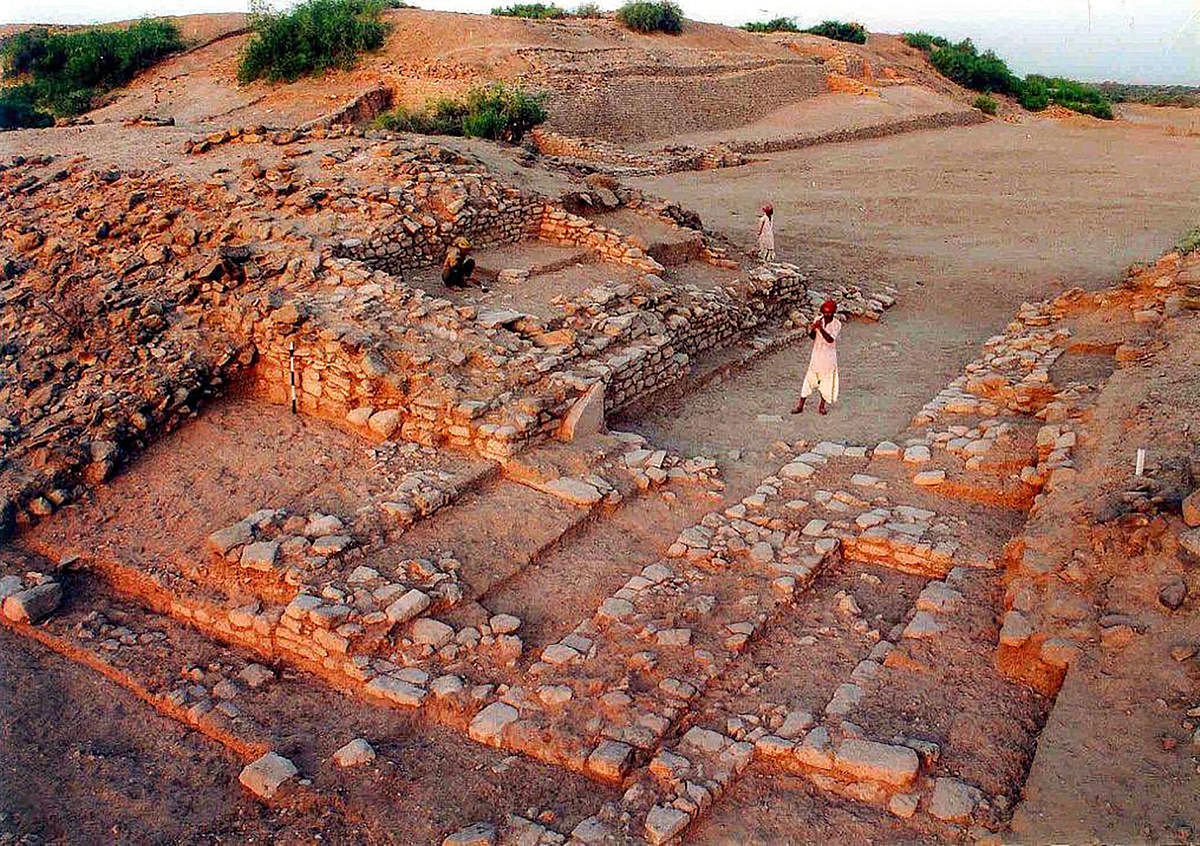

India’s most recent UNESCO World Heritage site, Dholavira was a sprawling urban centre in the Harappan civilisation, existing around 3000-1500 BCE. The others are ruins of Rakhigarhi in India and Harappa, Mohenjo-daro and Ganweriwala in Pakistan. From reading about it in history textbooks to visiting Dholavira, the Indus Valley Civilisation (Harappan civilisation) is quite a revelation. Dholavira is situated in the Kutch district of Gujarat on the Khadir Bet (island) in the Bhachau taluka, surrounded by the Rann of Kutch Lake.
A journey to the archaeological remains of Dholavira is akin to travelling back in time. The drive from Bhuj to Dholavira is enchanting through the flat Rann of Kutch stretching for miles, covered in sand with a shimmering crust of salt. The lonesome asphalt road cuts through the vast wilderness, bereft of any vegetation and not a single soul in sight. It might appear like leaving an era to enter another, lending a poetic touch to the journey in search of a lost civilisation.
Discovered by J P Joshi in 1966, the Archaeological Survey of India conducted extensive excavations during the nineties led by Director R S Bisht, an acclaimed archaeologist. It revealed many new facets to the Harappan civilisation. Dholavira and Lothal (near Ahmedabad) are the only two sites showing the seven stages of civilisation from development, maturity to its end, spanning 2900-1500 BCE, unlike others found in early or late stages only.
“From 1996 onwards we saw tourists here. The archaeological site got its name Dholavira after our village name that is two kilometres away,” said Tulsi Makwana, a local guide. He said a small museum displays some artefacts and photographs but all important finds are housed in the National Museum in Delhi.
“The entire village got involved in the digging when the archaeologists first came in 1990,” reminisces Jaimal Makwana, Tulsi’s father. His ability to learn fast and his proficiency in Hindi gave him the opportunity to work under R S Bisht for 15 years.
“Every brick and stone speaks volumes, and we could hear them speak,” said Jaimal, pride and emotions evident in his voice. He should know having dug the ancient site brick by brick with others. When he had found the outer mud-brick wall of the city and dug it intact, the appreciation he got from Bisht remains close to his heart.
The entire city appeared to be divided into a citadel on a higher mound, the middle and lower part signifying the living quarters based on the social hierarchy. One of the best-preserved urban settlements, an immaculate town planning reflected the architectural and technological achievements of that era. Evidence of well laid out streets, houses, drainage, cemetery, stadium, ceremonial ground and series of reservoirs is seen.
The art and craft skills are gauged from the excavated remnants of glazed earthenware, pottery, limestone pillars, bead processing workshops, artefacts of copper, shell, stone and jewellery in gold, terracotta, semi-precious stones and beads.
“We are amazed to find beads as small as mustard seeds with holes to make jewellery,” said Jaimal.
Everyday objects like fish hooks, tools, urns, animal figurines, pottery, seals and weights are found. There is enough evidence to suggest inter-regional trade and those with Mesopotamia and the Oman peninsula. But most intriguing are the 10 large stone inscriptions in Indus valley script, that remains undeciphered.
Visitors to Dholavira marvel at the rainwater harvesting mechanism, something to learn from an ancient civilisation. It was an arid land, drained by two seasonal streams, Mansar and Manhar that dried up in summer.
You could see small channels from houses joining bigger ones in streets that opened into deeper aqueducts attached to large tanks within the city. The reservoirs had stairs so cleaning could be done, and was built in two levels to allow sedimentation so clean water remained in the upper level. “A sophisticated water management system demonstrates the ingenuity of the Dholavira people in their struggle to survive and thrive in a harsh environment,” cites the UNESCO world heritage site.
“A lot of queries are coming after Dholavira got a UNESCO world heritage tag,” said Pravin Ahir, a resort owner. “It’s very peaceful here with no pollution, far away from Gujarat’s industrial area,” he added. There is more in antiquity here for there is the Khadir Bet Fossil Park nearby, which has Jurassic age plant fossils dating back to 176-187 million years.
It is not just the ruins and fossils but the pristine nature that attracts nature lovers. The soothing sunset every day and the white Rann turning into a silvery landscape during the full-moon night are memorable experiences. The flock of flamingos visiting the Rann Lake from August to November is a sight to behold. The folk music, Kutch embroidery by women, leather craft and delicious Kutchi cuisine completes the Dholavira excursion.
How to get to Dholavira
By road: Dholavira is 250 km (5-6 hrs drive) from Bhuj via Bhachau and Rapar village.
Dholavira is 335 km (7 hrs drive) from Ahmedabad.
By rail: Bhuj is the closest railway station to Dholavira.
By air: The Rudra Mata Airport at Bhuj is the nearest airport to Dholavira.